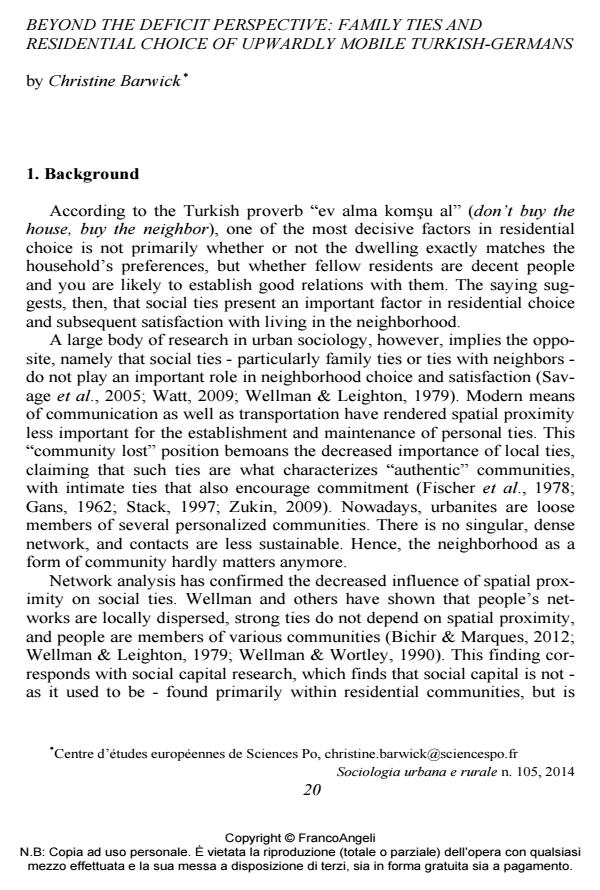Beyond the deficit perspective: family ties and residential choice of upwardly mobile turkish-germans
Journal title SOCIOLOGIA URBANA E RURALE
Author/s Christine Barwick
Publishing Year 2014 Issue 2014/105
Language English Pages 16 P. 20-35 File size 208 KB
DOI 10.3280/SUR2014-105002
DOI is like a bar code for intellectual property: to have more infomation
click here
Below, you can see the article first page
If you want to buy this article in PDF format, you can do it, following the instructions to buy download credits

FrancoAngeli is member of Publishers International Linking Association, Inc (PILA), a not-for-profit association which run the CrossRef service enabling links to and from online scholarly content.
Nelle moderne società urbane, si potrebbe pensare che la presenza dei mezzi di trasporto e di comunicazione, rendano il ruolo delle relazioni sociali meno importante nella decisione del quartiere in cui vivere e nella mobilità intraurbana più in generale. La decisione di dove vivere all’interno di un contesto urbano dovrebbe essere svincolata dalla prossimità spaziale con amici e parenti. Il contributo illustra come tali decisioni siano in realtà più complicate, attraverso il caso studio degli immigrati turchi di seconda generazione che hanno sperimentato una mobilità ascendente. I risultati empirici evidenziano in particolare il ruolo della famiglia nella decisione di dove risiedere.
Keywords: Selection of The Neighborhood, Family Ties, Movers, Belonging, Middle Classes, Turkish-germans.
- Andreotti A., Le Galès P. (2011). Elite, Middle Classes and Cities. In (ed.). Favell A., Guiraudon V. Sociology of the European Integration. Basingstoke: Palgrave Macmillan.
- Andreotti A., Le Galès P., Moreno Fuentes F.J. (2010). Controlling the Urban Fabric. The Complex Game of Distance and Proximity in European Upper-Middle Classes’ Residential Strategies. Working papers du programme Villes & Territoires, 2010, Paris, Sciences Po.
- Andreotti A., Le Galès P., Moreno Fuentes F.J. (2013). Controlling the Urban Fabric: The Complex Game of Distance and Proximity in European Upper-Middle-Class Residential Strategies. International Journal of Urban and Regional Re-search, 2: 576-97. DOI: 10.1111/j.1468-2427.2012.01177.
- Andreotti A., Le Galès P., Moreno Fuentes F.J. (2013). Transnational Mobility and Rootedness: The Upper Middle Classes in European Cities. Global Networks, 1: 41-59. DOI: 10.1111/j.1471-0374.2012.00365.x
- Bichir R.M., Marques E. (2012). Poverty and Sociability in Brazilian Metropolises: Comparing Poor People’s Personal Networks in SÃo Paulo and Salvador. Connections, 1: 20-32.
- Blokland T. (2003). Urban Bonds: Social Relationships in an Inner City Neighbourhood. Cambridge: Wiley-Blackwell.
- Blokland T., Savage M. (2001). Networks, Class and Place. International Journal of Urban and Regional Research, 2: 221-26. DOI: 10.1111/1468-2427.00308
- Bourdieu P. (1987). Distinction. A Social Critique of the Judgement of Taste. Cambridge, Mass.: Harvard University Press.
- Brown L.A., Moore E.G. (1970). The Intra-Urban Migration Process: A Perspective. Geografiska Annaler. Series B, Human Geography, 1: 1-13. DOI: 10.2307/490436
- BBB - Bürgschaftsbank zu Berlin-Brandenburg. (2013). Gründerindex. Sonderauswertung Nationalitätenvergleich. http://www.buergschaftsbank-berlin.de/materialien/BBBMaterialien37-2.pdf.
- Fischer C.S., Jackson R.M., Stueve C.A., Gerson K., McCallister Jones L., Baldassare M. (1978). Networks and Places. New York: Free Press.
- Gans H.J. (1962). The Urban Villagers. Group and Class in the Life of Italian-Americans. New York: Free Press.
- Gestring N., Janßen A., Ayca P., Siebel W. (2004). Die Zweite Genera-tion Türkischer Migranten. Einblicke, 40: 8–11.
- Horr A. (2008). Ethnische und soziale Unterschiede der Wohnungssuche und Wohnortwahl. In Hillmann F., Windzio M. Migration und städtischer Raum. Chancen und Risiken der Segregation und Integration. Opladen: Budrich UniPress, 175-192.
- Janßen A., Ayca P. (2005). Zwischen Integration Und Ausgrenzung: Lebensver-hältnisse Türkischer Migranten Der Zweiten Generation. Universität Oldenburg. http://oops.unioldenburg.
- de/126/.
- Kecskes R. (1994). Abwanderung, Widerspruch, Passivität. Oder: Wer Zieht Wann Um? Kölner Zeitschrift Für Soziologie Und Sozialpsychologie, 2: 129–44.
- Le Galès P. (2002). European Cities: Social Conflicts and Governance. New York, Oxford: Oxford University Press.
- Logan J.R., Spitze G.D. (1994). Family Neighbors. American Journal of Sociology, 2: 453-
- 76.
- Rossi P.H. (1980). Why Families Move. Beverly Hill, CA: Sage Publications, Inc.
- Savage M., Bagnall G., Longhurst B. (2005). Globalization and Belonging. London: SAGE. Schneider N., Spellerberg A. (1999). Lebensstile, Wohnraumbedürfnisse Und Räumliche Mobilität. Opladen: Leske+Budrich,.
- Spilimbergo A., Ubeda L. (2002). Family Attachment and the Decision to Move by Race. SSRN Scholarly. Paper ID 879612. Rochester, NY: Social Science Research Network. http://papers.ssrn.com/abstract=879612.
- Stack C.B. (1997). All Our Kin: Strategies for Survival in a Black Community. New York: Basic Books.
- Watt P. (2009). Living in an Oasis: Middle-Class Disaffiliation and Selective Belonging in an English Suburb. Environment and Planning A, 12: 2874–92. DOI: 10.1068/a41120
- Weber M. (1978). Economy and Society: An Outline of Interpretive Sociology. Berkeley: University of California Press.
- Wellman B., Leighton B. (1979). Networks, Neighborhoods, and Communities. Urban Affairs Review, 3: 363 –390.
- Wellman B., Wortley S. (1990). Different Strokes from Different Folks: Communi-ty Ties and Social Support. The American Journal of Sociology, 3: 558–88.
- Wilhelm G. (2011). Generation Koffer: Die Pendelkinder Der Türkei: Die Zurückgelassenen Kinder. Verlag: Orlanda Verlag.
- Wolpert J. (1965). Behavioral Aspects of the Decision to Migrate. Papers of the Regional Science Association, 1: 159–69. DOI: 10.1007/BF01947871
- Zorlu A. (2009). Ethnic Differences in Spatial Mobility: The Impact of Family Ties. Population, Space and Place, 4: 323–42. DOI: 10.1002/psp.560
- Zukin S. (2009). Naked City: The Death and Life of Authentic Urban Places. New York, Oxford: Oxford University Press.
- La configurazione spaziale delle politiche sociali in alcune aree del disagio napoletano Stefania Ferraro, in SOCIOLOGIA URBANA E RURALE 111/2017 pp.117
DOI: 10.3280/SUR2016-111008
Christine Barwick, Beyond the deficit perspective: family ties and residential choice of upwardly mobile turkish-germans in "SOCIOLOGIA URBANA E RURALE" 105/2014, pp 20-35, DOI: 10.3280/SUR2014-105002